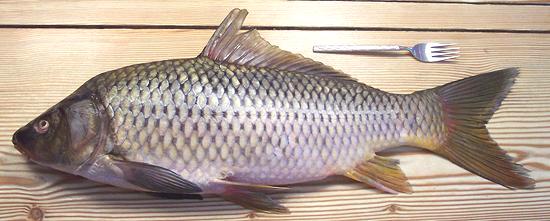 [Cyprinus carpio carpio]
[Cyprinus carpio carpio]
Possibly originating in the Danube river, these fish have been transplanted all around the world and have become pests in some areas. They can grow to 80 pounds and 47 inches long but the photo specimen was 25-3/4 inches and weighed 7 pounds.
This is a highly commercial fish just about everywhere except North America, where fancy varieties are used mainly as a landscaping accent. Common Carp prefer larger lakes and slow moving streams with muddy bottoms and eat just about anything. Wild carp and decorative koi tend to be less deep of body and without the distinct hump typical of farmed carp.This fish has been farmed since at least the time of the Roman Empire. About 3,300,000 tons per year of this carp are farmend, 70% farmed in China.
In England (also France) there are recreational "Catch and Release" carp ponds for fishing enthusiasts (carp are not easy to catch). If the mangement suspects you are an Eastern European they will not let you in. Eastern Europeans don't understand the "release" part, and try to take the carp home for dinner.
Two genetic variations of this carp popular in the fishing ponds are the Mirror Carp, with an incomplete coverage of very large mirror-like scales, and the Leather Carp, with just a few scales along the back and/or near the tail. Individuals are easily identified by scale pattern, so most over 40 pounds have been given names. Heather the Leather was the most famous, at 50 years old and 52 pounds. Hundreds of people came from all over Europe to try to catch her, but she was a wary fish and was only caught about 3 times a year.
More on the Carp Family.
The flesh of Common Carp is white, tender, smooth in texture and mild with practically no "fishy" taste. Just about anyone should find it enjoyable - but, Common Carp does, like all carp, have a "spine problem". Some find these thread-like spines rather annoying, but unlike those of the milkfish they are impossible to remove before cooking. To enjoy delicious carp, Americans just have to learn to deal with the spines at the table like the rest of the world does. If you don't want to deal with them, use catfish instead (unless you're an observant Jew or Muslim - catfish isn't kosher or halal). Strangely, though I have read many carp recipes in cookbooks from many cuisines, not a single recipe has mentioned this spine problem.
Personally I don't have a problem with the spines. As with most fish I eat carp with chopsticks, breaking it up as I go along. The spines are large and are easy to find that way. In any case, do provide a small bowl or some other way for your guests to dispose of the spines. Even in formal Victorian society it was permissible to remove fish bones from the mouth (but nothing else).
There's no need to skin Common Carp, but some picky eaters just won't eat skin, so you may want to serve filets skin side down so such people can leave it on the plate easily, or you can easily peel it off after cooking.
The whole fish is often cut into segments and cooked skin-on as in the Polish recipe for "Carp Jewish Style". This calls for the carp to be cut into chunks and the head to be split in half. The halves are laid over the vegetables along with the chunks for cooking (head to be removed before serving).
Another way carp is prepared is to cut the flesh into segments but leave the backbone intact. After cooking the backbone will no longer hold the fish together and the segments can be distributed easily.
Note: this 7 pound carp in the photo showed all signs of being a fresh fish (bright eyes, red gills, springy flesh, clean, firm innards) but did have a fairly strong musky odor with a hint of ammonia. After thoroughly scrubbing the outside of the fish the odor was completely gone.
sf_carpcoz* 060927 r 090322 - www.clovegarden.com